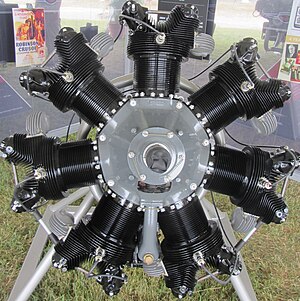avia.wikisort.org - Engine
The Continental R-670 (factory designation W670) was a seven-cylinder four-cycle radial aircraft engine produced by Continental displacing 668 cubic inches (11 litres) and a dry weight of 465 lb (211 kg). Horsepower varied from 210 to 240 at 2,200 rpm. The engine was the successor to Continental's first radial engine, the 170 hp Continental A-70. This engine was used on many aircraft in the 1930s and 1940s. The R-670 was widely used in the PT-17 Stearman primary training aircraft of the U.S. military.[1]
| R-670 | |
|---|---|
 | |
| Continental W670 on display | |
| Type | Piston aircraft engine |
| Manufacturer | Continental Motors |
| First run | 1934 |
| Major applications | PT-17 Stearman M3 Stuart |
In addition to being used in aircraft, the R-670 was used in a number of light armored vehicles of World War II.
Variants
Data from: Jane's All the World's Aircraft 1938[2] Variants of the W670 included:
- W670-K
- carburetor, 5.4:1 compression, 65 Octane, front exhausts and 225 hp (168 kW)
- W670-L
- carburetor, 5.4:1 compression, 73 Octane, rear exhausts and 225 hp (168 kW)
- W670-M
- carburetor, 6.1:1 compression, 80 Octane, front exhausts and 240 hp (179 kW)
- W670-N
- carburetor, 6.1:1 compression, 80 Octane, rear exhausts and 240 hp (179 kW)
- W670-K1
- fuel injection, 5.4:1 compression, 73 Octane, front exhausts and 230 hp (172 kW)
- W670-L1
- fuel injection, 5.4:1 compression, 73 Octane, rear exhausts and 230 hp (172 kW)
- W670-M1
- fuel injection, 6.1:1 compression, 80 Octane, front exhausts and 250 hp (186 kW)
- W670-N1
- fuel injection, 6.1:1 compression, 80 Octane, rear exhausts and 250 hp (186 kW)
Applications
Aircraft
- American Airmotive NA-75
- Boeing-Stearman Model 75 (PT-17, N2S)
- CallAir Model A
- Cessna 190
- Eagle Aircraft Eagle 220
- Fairchild PT-23
- Funk F-23
- G class blimp
- Grumman G-164 Ag Cat
- Kellett K-2A, K-4
- Morane-Saulnier MS.317
- Timm N2T Tutor
- Waco 240-A
- Waco Standard Cabin series (UEC, UIC, UKC, UKC-S, UKS, VKS)
- Waco Custom Cabin series (UOC, VQC)
- Waco A series (UBA, ULA)
- Waco F series (UBF, UMF, UPF)
Armored fighting vehicles
- T2 Combat Car
- T4 Combat Car
- M1 Combat Car
- M2 Light Tank
- M3 Stuart
- Landing Vehicle Tracked (LVT-2, -4; LVT(A)-1, -2, -4, -5)
Specifications (R-670-K)

Data from Jane's 1938[2]
General characteristics
- Type: Seven cylinder air-cooled radial
- Bore: 5+1⁄8 in (130.2 mm)
- Stroke: 4+5⁄8 in (117.5 mm)
- Displacement: 668 cu in (10.95 l)
- Length: 34+3⁄16 in (868.4 mm)
- Diameter: 42+1⁄2 in (1,079.5 mm)
- Dry weight: 450 lb (204.1 kg)
Components
- Valvetrain: 1 inlet and 1 exhaust valve per cylinder
- Fuel system: 1 Stromberg NA-R6 Carburetor
- Fuel type: 65 octane
- Oil system: Dry sump, one pressure pump, one scavenge pump, enclosed valve-train
- Cooling system: Air-cooled
Performance
- Power output: 225 hp (168 kW) at 2,175 rpm
- Specific power: 0.337 hp/in³
- Compression ratio: 5.4:1
- Fuel consumption: 13 US Gal/hr (49 L/hr) at cruising rpm
- Specific fuel consumption: 0.54 lb/hp/hr (0.328 kg/kW/hr) - at rated rpm
- Oil consumption: 0.4 US Gal/hr (1.5 L/hr) at cruising rpm
- Power-to-weight ratio: 0.49 hp/lb at cruising rpm
See also
Comparable engines
Related lists
References
Notes
- Gunston 1989, p.42.
- Jane's All the World's Aircraft 1938. London: Sampson, Low & Martin company Limited. 1938.
Bibliography
- Gunston, Bill. World Encyclopaedia of Aero Engines. Cambridge, England. Patrick Stephens Limited, 1989. ISBN 1-85260-163-9
- Jane's Fighting Aircraft of World War II. London. Studio Editions Ltd, 1998. ISBN 0-517-67964-7
- Jane's All the World's Aircraft 1938. London: Sampson, Low & Martin company Limited. 1938.
External links
На других языках
[de] Continental R-670
Der Continental R-670 (interne Bezeichnung W670) ist eine Siebenzylindersternmotor für Flugzeuge, der vom US-amerikanischen Hersteller Continental gebaut wurde. Er verfügt über einen Hubraum von elf Litern und ein Trockengewicht von 465 lb (211 kg). Die Leistung variiert von 210 PS (154 kW) bis 240 PS (177 kW) bei einer Drehzahl von 2200 min−1. Der Motor war der Nachfolger des ersten Sternmotors von Continental, dem Continental A-70. Er wurde in vielen Flugzeugen der 1930er und 1940er Jahre eingesetzt, zum Beispiel in der PT-17 Stearman des US-Militärs.[1]- [en] Continental R-670
[ru] Continental R-670
Continental R-670 (заводское обозначение W670 ) — серия американских 7-цилиндровых четырёхтактных радиальных авиационных двигателей производства Continental Motors. Мощность варьировалась от 210 до 240 л. с. при 2200 об / мин. Двигатель был преемником первого радиального двигателя Continental , 170-сильного Continental A-70. Этот двигатель использовался на многих самолётах в 1930-х и 1940-х годах. R-670 широко использовался в самолётах первичной подготовки пилотов PT-17 Stearman вооружённых сил США[1]. Помимо использования в самолётах, R-670 использовался в ряде легких бронированных машин времён Второй мировой войны.Другой контент может иметь иную лицензию. Перед использованием материалов сайта WikiSort.org внимательно изучите правила лицензирования конкретных элементов наполнения сайта.
WikiSort.org - проект по пересортировке и дополнению контента Википедии